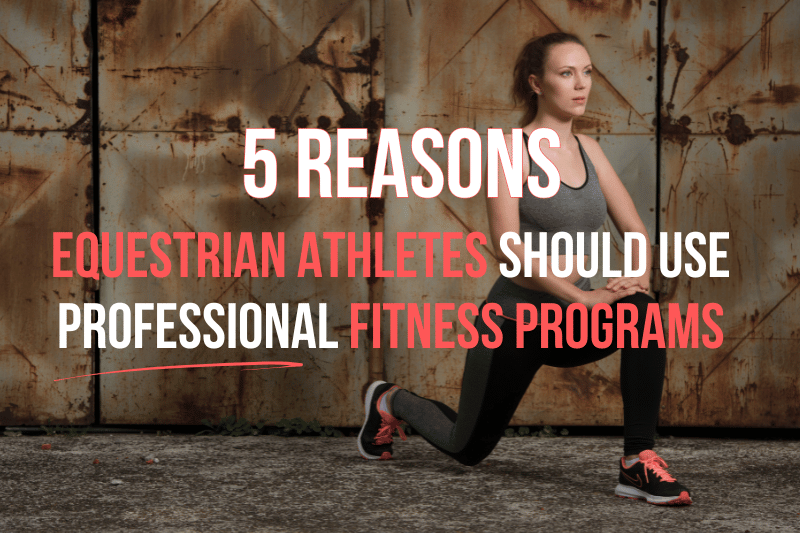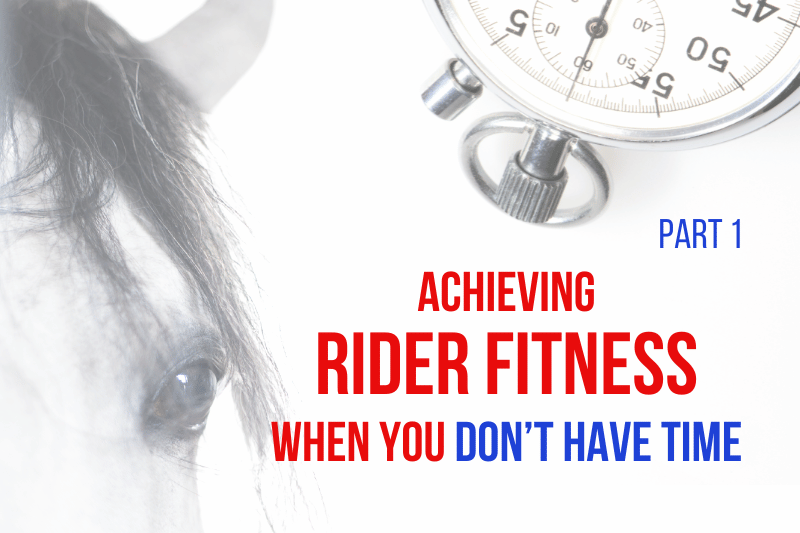Serious equestrians understand the need for cross-training. Personal fitness makes us stronger, more empathetic riders.
Although it’s tempting to go it alone on exercise, reserving coaching for our primary sport, there are compelling reasons for equestrian athletes to implement fitness programs that were designed by professionals.
In this post, I’ll make a case for the value of professionally-developed fitness programs for riders. I’ll also recommend some inexpensive, high quality options to get you started.
Why I Switched to Professional Fitness Programming
I’ve been a fitness geek as long as I’ve been endurance riding. For about fifteen years, I designed my own workout routines. I felt comfortable doing so, in light of myriad hours spent absorbing fitness-related books and podcasts.
It worked reasonably well. I was certainly fitter than the majority of my peers throughout my late twenties and thirties. In my early forties, though, a combination of lifestyle changes (read: life distractions) and advancing age conspired to make me weaker than I’d been in over a decade.
Carrying feed bags up the hill to the shed was harder than it should be. I couldn’t run with my horse as easily as I once did. Even little things, like trimming hooves, pointed out that my strength wasn’t where it used to be. The mirror, too, said I’d lost muscle.
Given the indisputable value of muscle mass and high VO2 max for optimal lifespan and healthspan, I took my own deficiencies very seriously. So, I sat down with myself and came up with a plan.
This time, it wasn’t my own plan. I was going to enlist the experts. Here’s why:
5 Reasons Equestrian Athletes Should Use Professional Fitness Programs
1. Outsourced Expertise
HIIT or Zone 2? Low-weight-high-rep or high-weight-low-rep?
You don’t need to know the answers to get great results. Instead of spending time parsing through the plethora of (often conflicting) fitness advice on the internet, why not rely on someone who understands proven principles?
Fitness professionals know how to develop programs that apply concepts like periodization and progressive overload. They know which methods build strength vs. hypertrophy and V02 max vs. endurance. They know how to stress the body just enough that it recovers a little better than before. By relying on their knowledge, we can reap the results even if we don’t fully understand the physiology behind it.
The good news is that accessing professional programming doesn’t need to be expensive or time-consuming. Unless you’re rehabbing an injury or have good reason to be afraid of damaging yourself, you can likely get significant benefit from a reputable program without coughing up for a live coach.
Once you choose a program, it’s usually best to follow it to the letter, at least for your first time through. Trust the process. See how it works before making modifications. Chances are, you’ll realize that the program was designed as it was for a reason.
2. Novel Stimulus
You know the expression: Do what you’ve always done, and you’ll get what you’ve always gotten.
This couldn’t be truer anywhere than in rider fitness. It’s why doing those same barn chores year after year never makes you any fitter. Your body already made the necessary adaptations to meet those demands. If you want to progress, you need to try something new.
The right fitness program will introduce you to new movements and more difficult challenges than you’d come up with on your own. This novel stimulus will force your body to adapt, resulting in improved strength and cardiovascular fitness.
3. Progressive Overload
Similarly, a professional fitness program will incorporate progressive overload. This is the concept of steadily increasing the burden on your systems (cardiovascular, respiratory, nervous) and structures (musculoskeletal) through a cycle of breakdown and recovery.
Progressive overload is the concept I see most frequently neglected by exercisers. So many people churn out that same 30 minutes on the elliptical, year after year, and wonder why their bodies don’t change…except to lose ground as they age.
If you don’t give your body a reason to improve, I guarantee it isn’t going to. A good fitness program will progressively push you to do more. “It never gets easier,” director Jordan Hoechlin said. “You just get better.”
4. Accountability
Quality fitness programs don’t have to be expensive, but they typically aren’t free, either. We all know that we’re more likely to stick with something for which we’ve chosen to pay.
Additionally, having a coach (even a virtual one) often motivates us to try harder. As humans, we’re all prone to micro-quitting. Micro-quitting ~ a useful concept I discovered in Trail Runner Magazine ~ is subtly deciding to go a little easier than planned, rather than giving a workout our all. We’re less likely to do that with a program to hold us accountable.
5. Accomplishment
When you try a professional fitness program, you’ll almost certainly see better results than you were getting on your own. In fact, you will likely see more improvement than you’ve enjoyed in a long time…possibly more than you thought possible.
That’s exactly what happened to me.
What Happened When I Switched to Professional Fitness Programming
Just over a year ago, I launched into professional strength training and running programs with aspirations of regaining functional strength. I wanted to increase muscle mass and lean out a little. And, I figured it would be fun to train for a goal 10K trail race.
Well. I did gain muscle mass, and I did lean out. Full, round muscle bellies took over my skinny arms. I discovered that I could trim 8 hooves, one after the other. My newly strengthened legs and core enabled me to squat my bodyweight. Persistent pain from old-injury-induced imbalances diminished.
I ran that 10K trail race last March and immediately decided it had been too easy. Mind you, this was after running exactly zero races since I was 22 years old. I’d started the year with no ambitions of running more than 6.2 miles at a go.
So naturally, I signed up for a half marathon. And then, two more.
As for running with my endurance horse? No problem!
Professional Fitness Programs I Recommend
Fitness programming takes many forms. You can choose anything from in-person trainers or online coaching to apps and even books.
Personal trainers are hit-or-miss. Excellent ones exist, of course, but just about anyone can hang out a shingle regardless of education or experience. If you want go with a live fitness coach, whether online or in-person, be sure to investigate their expertise before signing on the dotted line. This article provides some good questions to ask.
I’m a fan of programs that are delivered online, without the individualized coaching component. They’re significantly less expensive than personal trainers and come in a range of options suitable for almost any fitness level or goal.
Because I spend so much time in the fitness space, I had a pretty good idea where to look when I finally realized I should buy a program instead of continuing to design my own.
Here are my recommendations:
Strength Training Program Recommendations
I went with programming from Mind Pump Media. Their MAPS programs are designed by three guys I’ve followed for about a decade. Don’t let the “bruh” bodybuilder gloss scare you off. They’re extremely experienced with non-elite clients including everyday office workers, moms, and menopausal women, as well as athletes of all stripes.
Mind Pump has MAPS programs suitable for a broad range of abilities. All come with periodized workout calendars, specific workouts, and instructional videos. If you want even more guidance, you can always search YouTube for “Mind Pump [insert exercise here]” and you’ll get an excellent demo.
Here are a few Mind Pump programs that might interest you:
MAPS Anabolic ~ Remember, look past the bodybuilder gloss! Trust me! This is the first program I went with, and I’m running it for my third time right now. It’s appropriate for someone who wants a comprehensive strength training program involving 2-3 full body workouts per week, plus brief “trigger sessions” in between. It’s best implemented with access to a full gym, but does have an at-home option that you can do with some basic equipment, like dumbbells and resistance bands.
For newbies just getting started with strength training, MAPS Starter is an ideal introductory program requiring minimal equipment.
For those who travel a lot or need to work out at home, MAPS Anywhere is a good option requiring only resistance bands and a stick (even a broomstick will do).
Want to go up a notch? MAPS Suspension is a full-body program that requires only a suspension trainer. Suspension trainers are portable, fairly inexpensive (less than $150, and TRX is a reputable brand) and can be used anywhere you have a door for anchoring.
If time is tight, MAPS 15 Minutes is designed to strengthen your whole body in just 15 minutes per day. That’s plenty for people new to resistance training. I’m using it right now because it features suspension trainer exercises that are new to me (novel stimulus!) and I can fit in just a bit of resistance training between my full lifting days.
MAPS programs run around $100 each for lifetime access. If you aren’t in a hurry, sign up for their mailing list or listen to their podcast and wait for a sale. Several times per year, they offer up to 60% off. (I’m not an affiliate, by the way. Just a fan.)
Running Program Recommendations
I chose to use iFIT programming (specifically the 5K, 10K, and half-marathon race training progressions) on my NordicTrac treadmill. They were great for my situation, but since most people aren’t iFIT subscribers, here are some other options with which I’m familiar:
Jeff Galloway’s Run-Walk-Run is an oldie-but-goodie, time-tested method. It’s perfect for new runners because it utilizes very gradual progressive overload. I applied this method for my first half-marathon in my early twenties and remember it fondly. Back then, it was just the book, but now they have free basic plans plus paid customization options and an app.
Marathon Training Academy offers super friendly, professional coaching as well as inexpensive programs for runners of all levels who are interested in distance running (half-marathon and up). Even if you don’t buy anything, you should add their podcast to your playlist for humor and inspiration.
RunnersConnect is another source of excellent material. They use a subscription model for training plans with varying tiers of support for runners of all levels interested in all distances.
It’s tough to trade hard-earned cash for help with something that looks simple enough to manage on your own. However, when I finally made the leap, my fitness for riding advanced more ~ and more quickly ~ than I ever imagined.
From one rider to another, here’s my advice: Give professional fitness programming a try. You’ll be glad you did.
You might also Like:
This post includes affiliate links, and I may earn a small commission (at no extra cost to you) when you purchase through these links. I only recommend products and services I think are helpful and useful. Thanks for helping me offset the cost of maintaining this blog as a free resource!




Sarah Cuthbertson at ridelikeanathlete.com has an awesome fitness library of activities, live workouts and customized training options. Very affordable, and lots of ways to keep you motivated.